U n i v e r s i t é Y O R K U n i v e r s i t y
ATKINSON FACULTY OF LIBERAL AND PROFESSIONAL STUDIES
SCHOOL OF ANALYTIC STUDIES & INFORMATION TECHNOLOGY
S C I E N C E A N D T E C H N O L O G Y S T U D I E S
NATS 1800 6.0 SCIENCE AND EVERYDAY PHENOMENA
ATKINSON FACULTY OF LIBERAL AND PROFESSIONAL STUDIES
SCHOOL OF ANALYTIC STUDIES & INFORMATION TECHNOLOGY
S C I E N C E A N D T E C H N O L O G Y S T U D I E S
NATS 1800 6.0 SCIENCE AND EVERYDAY PHENOMENA
Lecture 4: Music of the Spheres
| Prev | Next | Search | Syllabus | Selected References | Home |
Topics
-
"The ancient Greeks believed that the planets and stars were embedded in crystal spheres that hummed as they
spun around the heavens, making the 'music of the spheres.' But all appeared quiet until the 1970's when
astronomers began discovering that the Sun and the other stars actually sing." [ from Melbourne Planetarium ]
…and not just stars, but also other exotic objects such as black holes.
Before reviewing this modern discovery, I want to mention that this Greek tradition is usually thought
to have been started by Pythagoras of Samos
(ca. 569 - ca. 475 BC). A nice introduction to Pythagoras, his ideas and his lasting influence, can be found in
Pythagoras & Music of the Spheres:
"there is geometry in the humming of the strings … there is music in the spacing of the spheres."
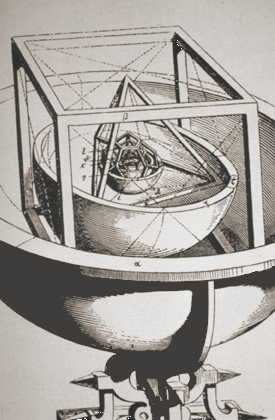
Kepler's (Pythagorean) Model of the Universe
You may want to visit Harmonice Mundi, where you can download "a tool for listening for harmonies of the first six planets in the solar system.""Have you ever wondered about harmony? Perhaps in music, have you ever suspected that there is something fundamentally mathematical happening? Imagine an astronomer who had the same suspicion. Four hundred years ago, Johannes Kepler reasoned that if there is math in musical harmony, then can math be used to find harmony in the universe? At the time, only the planets from Mercury to Saturn were known, and there were few, if any, musical instruments that could play the sounds that the math suggests. Now, you can listen for harmonies among the planets with this computer software."
-
By way of background, we also need to say a few words about sound. What is sound? Physicists define it as
"a pressure disturbance that propagates through a medium due to stress or displacement of the medium from
its equilibrium state." [ C Morris, ed., Academic Press Dictionary of Science and Technology Academic
Press, 1992 ]. When I clap my hands, I squeeze the air between them. This is the 'pressure disturbance.' The
squeezing action decreases the pressure of the air around my hands. Air adjacent to such area of lower pressure
rushes in, creating a new area of higher pressure and, in turn, leaving an area of lower pressure nearby, and so on.
The area of higher pressure and the adjacent one of lower pressure move therefore away from my hand, in all
directions. This is the 'propagation.' The resulting phenomenon is a traveling pressure wave, which is detected by the ear
and other suitable 'receivers' as a sound. The successive area of high and low pressure hit the eardrum's tympanic
membrane, making it vibrate. Such mechanical vibration is then transformed into periodic electrical pulses that
travel to the brain, where they are interpreted as sound.
Sound therefore requires a physical medium, such as air, water, steel, etc., to propagate. Sound can not propagate
in a vacuum. For example, since there is essentially no atmosphere on the Moon, no sound can be generated or
propagated above the surface of the Moon. But notice that sound can propagate below the lunar rocky surface.
Likewise, no matter what happens on the Sun, we can not hear any solar noise, since the gas and dust in the space between the Sun and the Earth are too tenuous for sound to propagate. How fast does sound propagate? At 0°C and at normal, sea-level atmospheric pressure, sound travels at about 330 m/s (or about 1290 km/hr, or about 740 mi/hr). In seawater, instead, at 23°C, sound travels at about 1530 m/s. In solids, say steel, sound can travel even faster. Notice, finally, that sound waves in gases and liquids are longitudinal, i.e. the back-and-forth vibrations of such media define the direction of propagation of the sound waves. In solids, depending on their shape and size, sound can also propagate transversally. A transverse way propagates at right angles relative to the direction of the vibrations. Of course, while we can not 'hear' the Sun, we can see it. Light waves are very different from sound waves. Light is a form of electromagnetic radiation, which is a disturbance of electromagnetic fields generated when electrical charges (or magnets) move. A moving charge, in addition to its electrical field, generates a magnetic field which, if the motion is accelerated, can in turn affect the electric field. The result is an electromagnetic disturbance, which propagates at right angles to the disturbance itself. Electromagnetic waves are said to be transveral. These waves can travel not only through various media, but also through vacuum (that's why we can see the Sun and the stars). Their speed is much higher than that of sound: about 299,800 km/s (or about 186,300 mi/s). Examples of electromagnetic waves are radio waves, radar waves, microwaves, x-rays, etc. Light is the particular kind of electromagnetic radiation our eye is capable of detecting. A nice visual resource for all types of waves is at Computer Animations of Physical Processes. -
We can now turn to black holes. In order to understand the basic nature of such an exotic object, we need
to examine, very briefly, the forces that hold a star together. In general, a star is a large body of gas held
together by its own gravity, which incidentally is responsible for the roughly spherical shape of the star.
The gravitational force is proportional to the mass of the gas. Therefore, if the mass of gas is sufficiently
large (at least approximately 1/100 the mass of our Sun), then the gas is compressed (and thus heated) to such
an extent that nuclear reactions are triggered deep inside the star. For example, if the gas is mostly hydrogen,
such nuclear reactions may lead to the fusion of hydrogen nuclei into helium nuclei, with the release
of huge amounts of energy in the form of electromagnetic radiation and energetic particles. This radiation clearly
works against gravity, but under 'normal' conditions a sort of equilibrium is reached between the two forces.
The Sun is a good and typical example of such 'stable' stars.
In about 5 billion years the Sun will run out of usable hydrogen. Therefore the outward radiation pressure
will cease to oppose gravity, which will be able to shrink—and therefore heat up—the Sun. This process
will be a dramatic one, as the Sun will lose its stability and undergo a series of transformations which will shed
substantial amount of matter, and will eventually lead to the cessation of all nuclear reactions. As a consequence,
the Sun will start cooling, as a much denser and smaller star called a white dwarf, not much bigger than
the Earth!
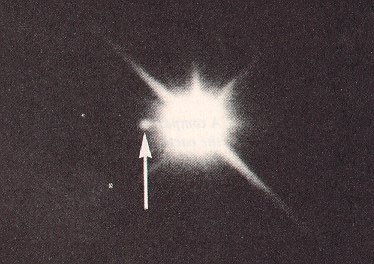
Sirius and Its White Dwarf Companion Serius B
If a white dwarf has a mass larger than about 1.4 solar masses (the so-called Chandrasekhar Limit), gravity will cause the implosion and subsequent explosion of the star (this phase is called supernova), yielding what is known as a neutron star. This is an object so dense that a teaspoon of its material weighs 100 million tons. However the effect of gravity would eventually be offset by the repulsion between neutrons, and any further shrinking would stop. But, if a white dwarf is more massive than about 2 solar masses, even this limit will be exceeded, and the star will collapse completely and spectacularly into a point or singularity, containing the entire mass of the star: a black hole. - When we deal with such extreme phenomena, the physics of Newton ceases to be applicable. Just as in the subatomic world, it turns out that things such as black holes behave very differently relative to our everyday world. In the presence of immense energies and masses, the very fabric of space and time acquire new properties, which are the province of Einstein's General Theory of Relativity. For example, space and time become entangled into a new entity, space-time; light, instead of traveling in straight lines, feels the presence of gravity, and follows a curved path. Notice that the situation is even more complicated than that. We have here, simultaneously present, the subatomic world and the cosmic world. Historically, the description and understanding (quantum mechanics and general relativity) of these two worlds developed independently, and we still lack a satisfactory synthesis. Notice also that at the singularity all physical laws break down, including quantum mechanics and general relativity. A singularity is a place of infinite density, and its gravitational force is so concentrated that nothing can escape its grip within a certain distance (the boundary of such area is called the event horizon of the black hole. Kurt Schwarzschild was able to calculate that the radius of the volume bounded by the event horizon is about 30 km for a black hole with 10 times the mass of the sun.). That's why these objects are called black holes. Nothing can leave this portion of space: no light, no matter, no information. In fact, the only information we have access to consists of the mass, the rate of rotation (if present), the radius of the event horizon, and the total electrical charge (if present). In other words, two black holes that have the same properties listed above are indistinguishable. That's why physicists say that "black holes have no hair." Notice, however, that recent work casts doubts on this conclusion.
-
The question therefore arises as to how we can possibly detect black holes. The only way we have is to look for
the effects of the black hole on the matter lying outside its event horizon. Such matter, if sufficiently close,
would be sucked in towards the black hole. This process would heat up this matter to truly astronomical temperatures,
causing it to emit electromagnetic radiation, for example x-rays. These could be detected. and could allow us
to infer the presence of the black hole, itself invisible. This is the case, for example, when another star orbits
a black hole. The black hole strips the star of its outer layers, drawing it more and more toward itself. As the
star moves closer and closer to the black hole it accelerates, and this acceleration is detectable.
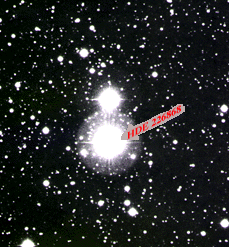
Cygnus X-1 and Its Visible Companion HDE226868
"Cygnus X-1 is believed to be a black hole binary, with a 20-35 solar mass black hole and a supergiant, orbiting around with a period of 5.6 days, as companion. The mass of the unseen companion, significantly larger then 5 solar masses, suggests that it is a black hole … Cygnus X-1 is one of the brightest X-ray sources in the sky." [ from Black Hole in Cygnus X-1 ]
Cygnus X-1 and Its Visible Companion HDE226868 (Artist's Conception)
-
Finally, it is important to realize that black holes, of much bigger sizes, are not simply the remnants of
supernovae. Giant black holes, with millions and billions of solar masses, lurk at the center of many galaxies,
including the Milky Way. See, for example, Galactic Black Holes.
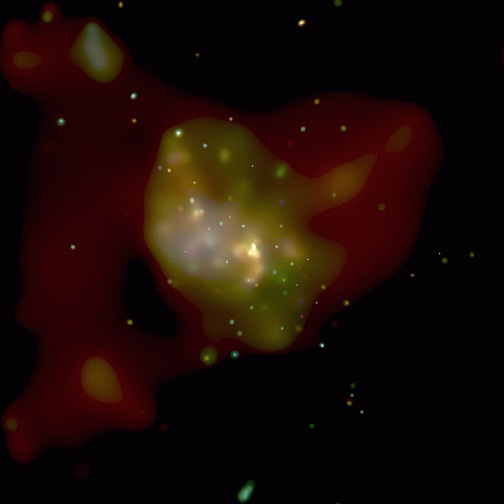
The Central Region of Our Milky Way Galaxy as Seen by Chandra
"Thirty million light years away, a monster rules the heart of a galaxy. With the gravity of a billion suns, it controls the movements of millions of stars in its domain. Long ago, it blazed with a light that eclipsed the galaxy it lives in. Today, it is dark and quiet. Looking at NGC 3115 in a telescope, we would not guess that it is present.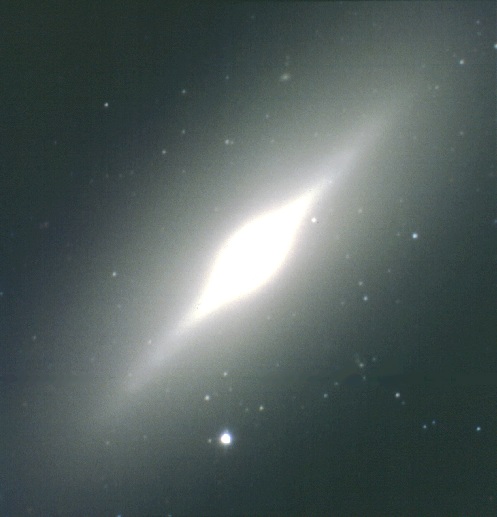
Galaxy NGC 3115 (Canada-France-Hawaii Telescope)
Such monsters lurk in the centers of many galaxies, including our own. They are almost surely black holes, an extremely dense form of matter predicted by the general theory of relativity. Soon after quasars were discovered in 1963, astronomers proposed that their tremendous luminosities come from matter falling into giant black holes. The confirmation of this idea has been one of the exciting sagas of modern astrophysics." [ from J Kormendy and G Shields' Monsters in Galactic Nuclei ]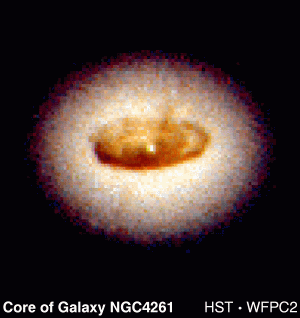
Galaxy NGC4261 (Hubble Space Telescope)
"The outer white area is the core or centre of the galaxy NGC4261.
Inside the core there is a brown spiral-shaped disk. It weighs one hundred thousand times as much as our sun. Because it is rotating we can measure the radii and speed of its constituents, and hence weigh the object at its centre. This object is about as large as our solar system, but weighs 1,200,000,000 times as much as our sun. This means that gravity is about one million times as strong as on the sun. Almost certainly this object is a black hole." [ from Cambridge Relativity: Black Holes ] -
So, where is the music? Active black holes, i.e. black holes which are in the process of swallowing nearby matter,
produce x-rays. "It is these X-rays, and the variations in their frequency and intensity, that make the music."
Of course, as we saw earlier, x-rays are not sound waves. However, if one takes the frequencies,
intensities, phases, etc. of these x-rays, and maps them to audible sound frequencies, intensities, phases, etc.,
the resulting sound patterns are a sort of representation of the x-ray patterns. This kind of translation
is not unlike the one you see in some of the radar pictures taken by orbiting satellites. As far as the human eye
is concerned, radar frequencies have no color—in fact they are invisible. It is possible however to map the range
of radar frequencies to the color spectrum. The resulting colors are then said to be 'false.'
"The music of a black hole is generated in the region just outside the black hole proper, where incoming
matter is accelerated to near-the-speed-of-light just before being swallowed. The notes and pauses are roughly
the same in faraway supermassive black holes, which can weigh more than a billion stars, as they are in
comparatively puny stellar black holes, which are typically just a few times as massive as the Sun and are found
here in our own galaxy.
A stellar black hole typically feeds off gas and dust provided by a companion star, while a supermassive black
hole can consume entire stars in a single gulp. So the similarity in their music implies that incoming matter's
final moments are governed by similar principles of physics, supporting a long-held suspicion." [ from The Music of Black Holes ]
To hear the sounds of a black hole, go to
 Pulse of the Planet
and click on Real Player or WinMedia.
Pulse of the Planet
and click on Real Player or WinMedia.
-
...but there is also true sound around at least some black holes!
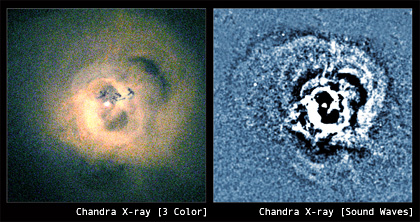
The Sound of a Supermassive Black Hole in the Perseus Cluster (Chandra)
"A 53-hour Chandra observation of the central region of the Perseus galaxy cluster (left) has revealed wavelike features (right) that appear to be sound waves [ … ] These sound waves are thought to have been produced by explosive events occurring around a supermassive black hole (bright white spot) in Perseus A, the huge galaxy at the center of the cluster. The pitch of the sound waves translates into the note of B flat, 57 octaves below middle-C. This frequency is over a million billion times deeper than the limits of human hearing, so the sound is much too deep to be heard. The image also shows two vast, bubble-shaped cavities, each about 50 thousand light years wide, extending away from the central supermassive black hole. These cavities, which are bright sources of radio waves, are not really empty, but filled with high-energy particles and magnetic fields. They push the hot X-ray emitting gas aside, creating sound waves that sweep across hundreds of thousands of light years." [ from Perseus Cluster: Chandra "Hears" a Supermassive Black Hole in Perseus ]
Remember that, even if our ears could detect such low-frequency sounds, we would still not hear them on Earth, because such sounds would have to propagate through the intergalactic medium, which is essentially empty of matter.
Readings, Resources and Questions
- Over the centuries Pythagoras' influence extended well beyond music. For example Leone Battista Alberti (1404-1472), one of the great Renaissance architects, said "'[I am] convinced of the truth of Pythagoras' saying, that Nature is sure to act consistently…I conclude that the same numbers by means of which the agreement of sounds affect our ears with delight are the very same which please our eyes and our minds.'" [ quoted in Pythagoras & Music of the Spheres... ]
-
The idea that the universe may have a geometrical structure, like the one proposed by Kepler (see image at the top of the page),
has now been revived, but on the basis of mounting experimental evidence and solid theoretical work. See for example
Jean-Pierre Luminet's article A Cosmic Hall of Mirrors
in Physics World.
"Most astronomers think that the universe is infinite, but recent measurements suggest that it could be finite and relatively small. Indeed, as Jean-Pierre Luminet describes, we could be living in an exotic universe shaped rather like a football."
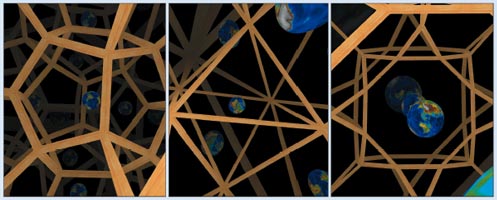
The Many Shapes of the Universe
- TVolume 2, n. 20 of The NSDL Scout Reports for the Physical Sciences presents a very useful set of links on The Physics of Sound.
- Here are a few good resources on black holes:
-
You can watch and hear a
movie that
"shows the Cassini spacecraft as it flew in and out of Saturn's ring plane, with accompanying sounds recorded by Cassini's radio and plasma wave science instrument. On June 30, 2004, the spacecraft crossed the ring plane, where its high-gain antenna was bombarded with dust particles that produced this cacophony of sound reminiscent of a hailstorm. Exiting the rings produces similar sights and sounds, which are seen at the end of the movie."
- It is interesting to note that many ancient cultures believed the stuff that makes up the heavens to be substantially different from that of our everyday, earthly world. In a sense, modern science continues this tradition. We now know in fact that some of the physical laws governing everyday phenomena are different from those governing the large-scale structure of the universe. Discuss.
- Visit Mark Whittle's home page, where you can download files with the "sound" of the background radiation [under "4) Sounds & Movies for playing & downloading"]. The BBC also has direct links to some of these files: see 'Birth Cry' of the Cosmos Heard .
- For more space sounds, visit Space Audio, where you will be able to hear "the 'sounds of space' collected by the U of Iowa instruments on various spacecraft[s]," including very recent data from Cassini, which on June 30, 2004 was inserted into an orbit around Saturn.
© Copyright Luigi M Bianchi 2003-2005
Picture Credits: Dartmouth College · Cambridge University
NCSA · NASA · ESO · Chandra · PhysicsWeb
Last Modification Date: 29 September 2005
Picture Credits: Dartmouth College · Cambridge University
NCSA · NASA · ESO · Chandra · PhysicsWeb
Last Modification Date: 29 September 2005